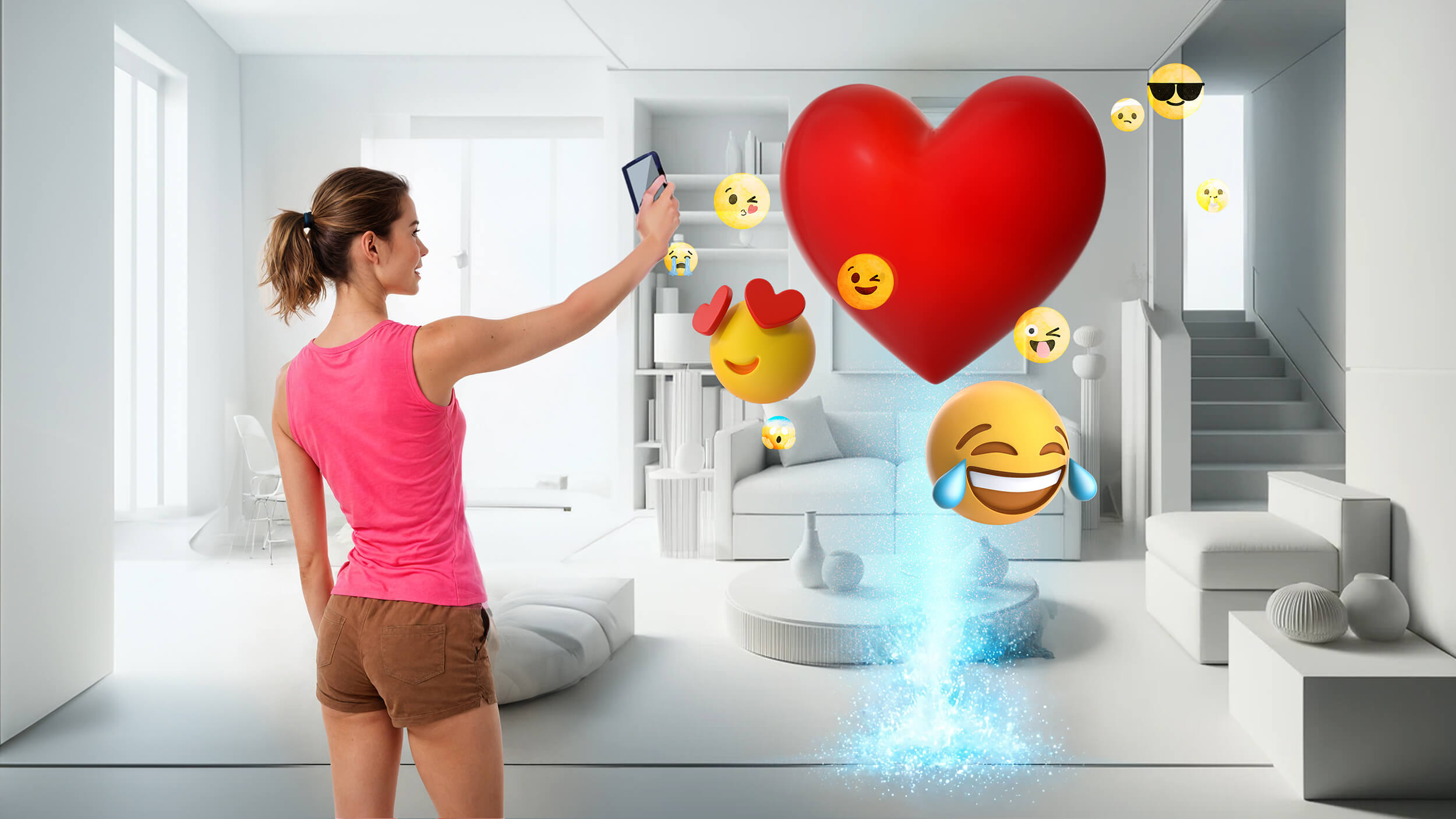
As three in four social media users experience ad fatigue—and social ads are perceived as less trustworthy than television ads—creative directors need a strategic shift to keep consumers engaged. By melding the virtual with the real, Augmented Reality (AR) implementations in social media offer an innovative canvas for user interaction. This fusion can revolutionize the way brands connect with their audiences, turning passive observers into active participants.
As social platforms integrate Augmented Reality features such as filters and virtual try-ons, users can enjoy immersive experiences that transcend traditional marketing boundaries—transforming the mundane into the remarkable. Research from Snap Inc. and Ipsos shows that 80% of brands implementing AR say it helps to drive sales, boost performance metrics, and acquire new customers.
The strategic use of AR in social media is not just enhancing the customer journey—it’s setting a new standard for how brand narratives unfold in the palms of our hands.
Key Takeaways
- AR technology opens opportunities for creators and advertisers to produce immersive and interactive experiences that appeal to new audiences and younger demographics.
- AR offers insights into user behavior and preferences by tracking interactions, engagement, and conversions. Brands can use this data to refine marketing tactics and create more customized content for users.
- Incorporating Augmented Reality in social media marketing can offer a competitive advantage by positioning brands as being forward-thinking, innovative, and customer centric.
- AR contributes to highly shareable content. Users are more likely to share unique and immersive experiences, thus increasing brand reach and exposure.
Let’s chat
Not sure where to start? Book a free strategy call with us to get started! No strings attached.
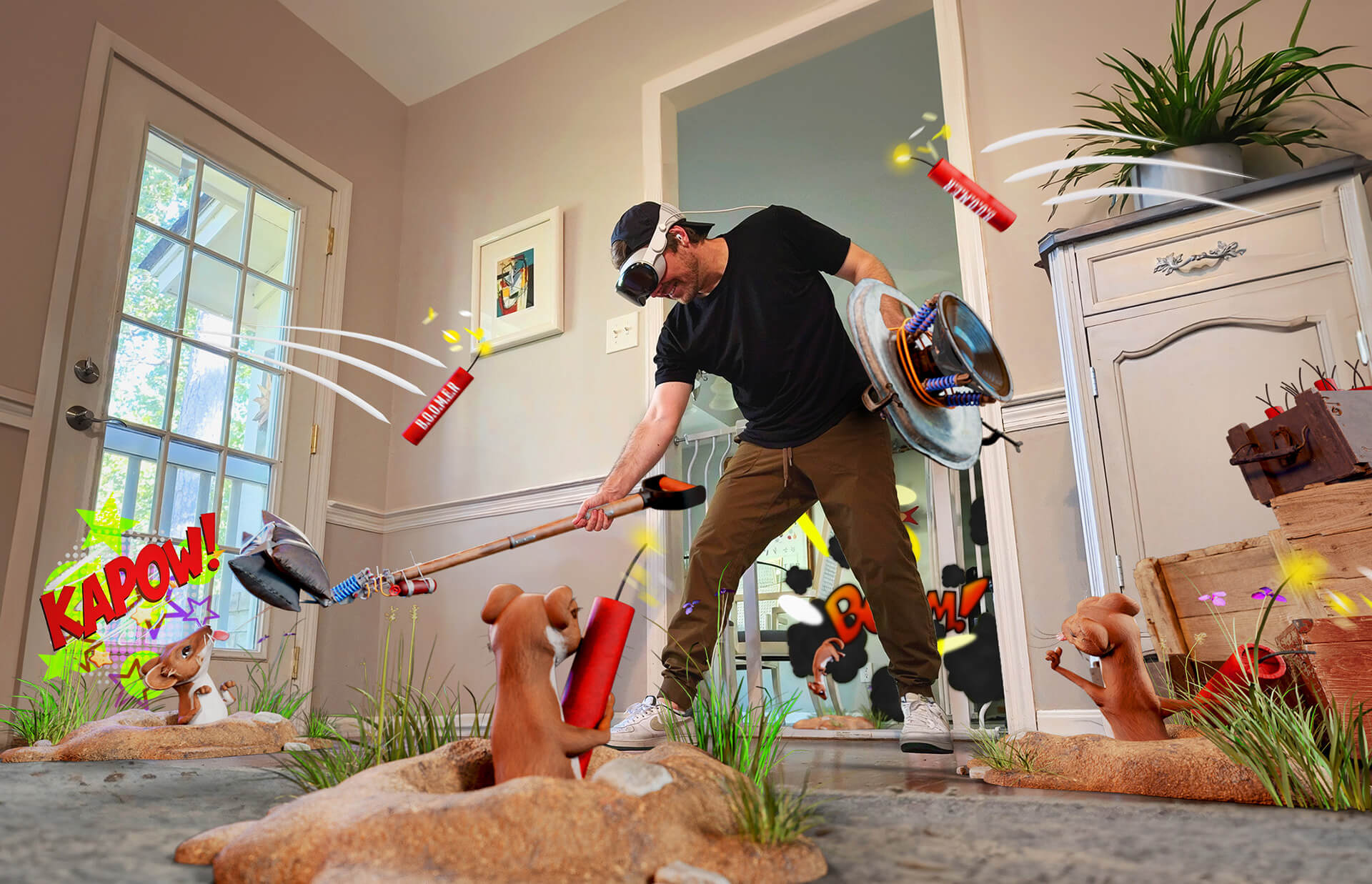
How Has the Use of Augmented Reality in Social Media Evolved?
Social media platforms like Twitter, Facebook and Instagram gained popularity in the mid-2000s, and rapidly became a fertile ground for self expression and experimentation with new technologies.
What is the History of AR in Social Media?
The introduction of AR filters and lenses to social media is largely attributed to Snapchat with the launch of Lenses in 2015. This feature allowed users to apply real-time effects to their faces using facial recognition technology. The popularity of these interactive, fun filters set a new trend in social media, encouraging users to share photos and videos with augmented overlays.
Snapchat’s success with Lenses sparked interest across the industry, leading other social media platforms to follow suit. Facebook and Instagram introduced similar AR filters in 2017; TikTok also joined the AR trend, incorporating filters and effects that allowed for creative and engaging user-generated content. These platforms have continued to evolve, offering brands and creators the opportunity to design custom AR experiences that align with marketing objectives and enhance user engagement. According to Statista, around 29.9 million people in the US used Augmented Reality on social media at least once per month in 2018. By 2022, that figure had risen to 48.3 million.

How is Augmented Reality Used by Social Media Influencers?
AR has become a handy tool for brand-influencer partnerships, providing novel ways to engage audiences. By leveraging AR, influencers can create unique and interactive content that can stand out in a crowded social media landscape.
Influencers may encourage their followers to use specific AR filters and share their own content with the intent of spurring viral engagement. AR filters allow influencers to offer something exclusive to their followers, cultivating a sense of community and creating hype around the brand or associated campaign.
Maybelline Thailand, for example, initiated the #SpreadGoodVibes campaign to promote digital positivity during the Covid-19 pandemic. As lockdowns moved consumers online, Maybelline employed AR technology to retain brand engagement. The company enlisted the help of five influencers to showcase the campaign, introducing three makeup styles symbolic of the brand’s core values: strength, passion, and optimism. The campaign featured makeup tutorials and product information, complemented by an interactive AR filter available on Maybelline’s Facebook and Instagram pages.
Augmented Reality in Social Media Marketing and Advertising
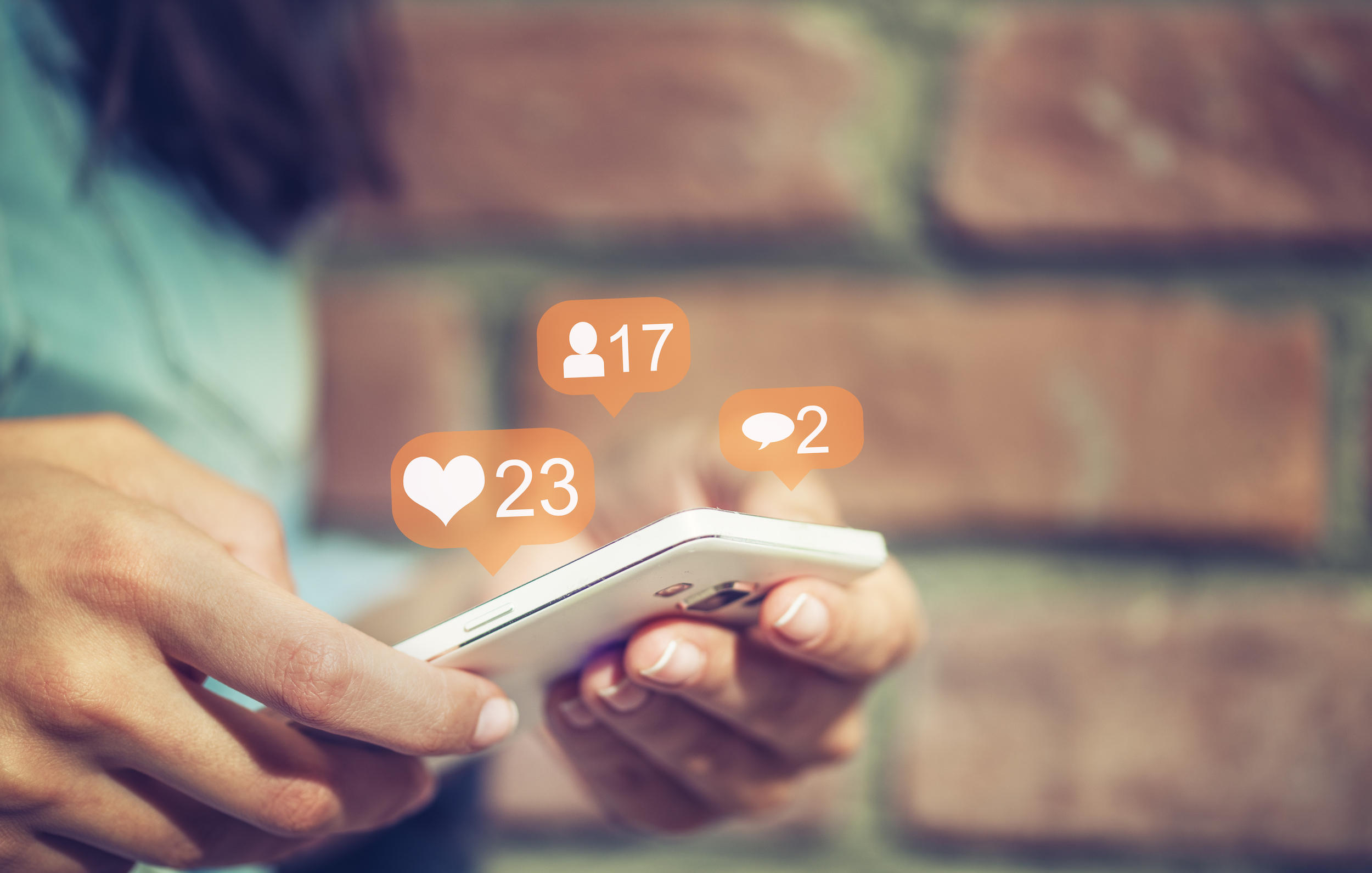
As highlighted, AR offers the potential to enhance user engagement through personalization, interactivity, and unique brand experiences. These elements not only make marketing campaigns more effective, but also help in building stronger customer-brand relationships.
How Can AR Enhance Marketing Campaigns on Social Media?
AR offers immersive and interactive experiences that can create higher levels of engagement than many traditional advertising initiatives. It turns static ads into dynamic experiences, making marketing messages more memorable. With the ability to see products in 3D and in real time, customers can gain a better understanding of products—potentially reducing uncertainty and increasing sales.
More than 40% of users say they are more likely to share a social media AR experience than other types of brand posts. Users are also more deeply immersed and spend more time engaging with content. Increased dwell time, along with higher click-through rates and social sharing, positively impacts engagement metrics.
By leveraging AR, brands can differentiate themselves as innovative and tech-savvy. As Gen Z and millennials are 71% more likely to use AR compared to older generations, this positioning can prove particularly appealing to younger demographics, who value cutting-edge technology and creativity.
Another key advantage is user behavior data obtained through AR interactions. Brands can analyze this data to gain insights into customer preferences, refine marketing strategies, and optimize future campaigns.
Keep up to date
Sign up to our newsletter for exclusive updates and content, delivered directly to your inbox.
What are Some Augmented Reality Social Media Examples?
Mini introduced an AR feature that allowed users to view a true-scale detailed model of the car in any desired location, from their driveway to their living room. This feature was integrated with Mini’s standard Facebook advertising campaign.
The campaign successfully reached 890,000 individuals, who engaged with the feature upward of 28 seconds on average. It resulted in nearly triple the increase in ad recall and over elevenfold improvement in brand favorability. Additionally, the campaign saw a sixfold increase in brand recommendations compared to the standard campaign.
Similarly, Gucci Beauty successfully engaged consumers in its own virtual adventure, launching an AR experience on Snapchat to promote its Bloom fragrance line in the US. The Snapchat portal AR lens transports users into the Gucci Bloom Garden of Dreams, adorned with dynamic fountains and vivid red roses. In this virtual garden, users explore a vibrant maze to look for hidden Bloom fragrance bottles. The experience also offered hidden surprises and directed users to the Gucci Bloom webpage.
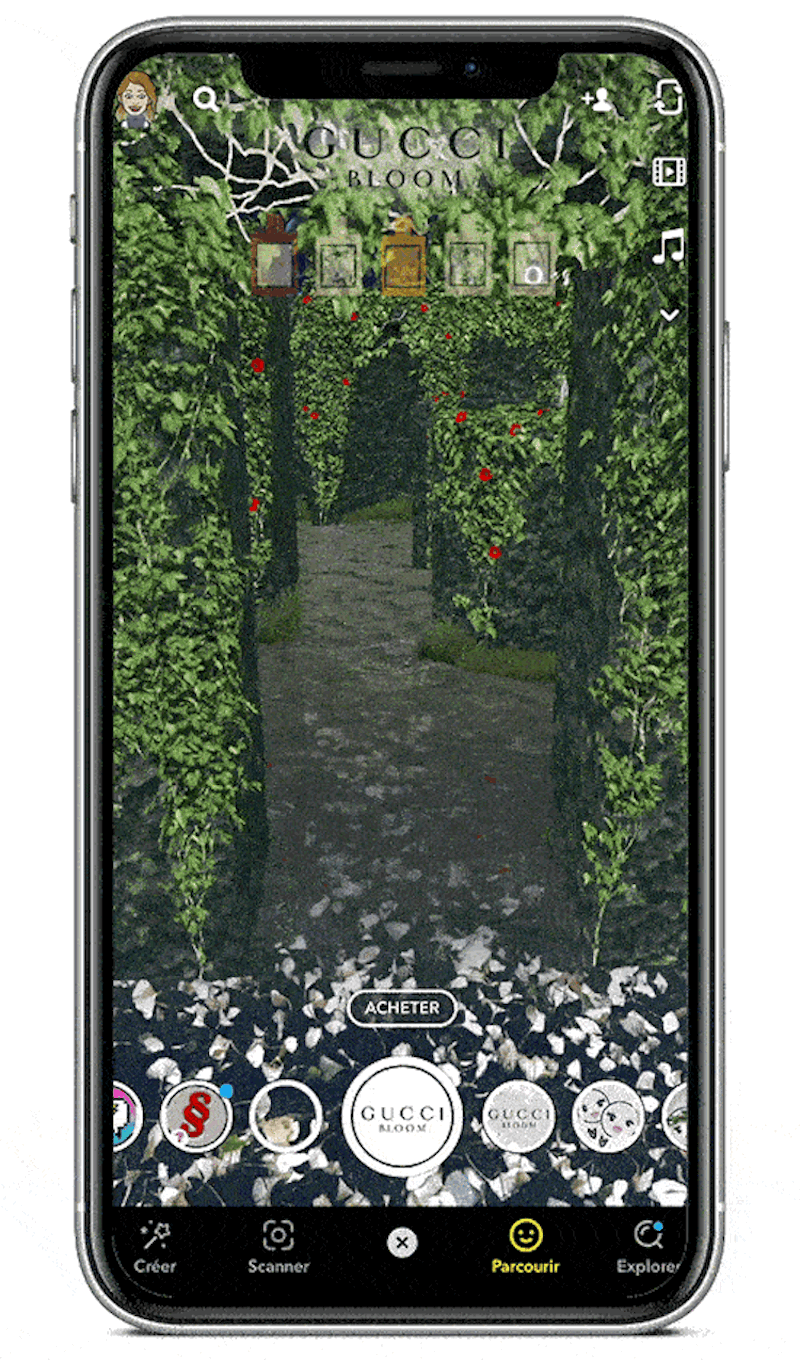
Credit: ar.rocks
How to Measure the Success of AR in Social Media Campaigns
To effectively measure the success of AR social media ad campaigns, it’s important to monitor both standard and AR-specific metrics that align with your campaign goals. Adopting a strategic approach in selecting the most meaningful metrics will help refine marketing tactics and enhance ROI.
Consider the following metrics to gauge campaign success and determine strategic adjustments:
- Audience reach—how many users who view or interact with the content
- Click-through rates (CTR)
- User engagement—this could be measured by average user interaction duration or repeat usage rate
- Conversion rates
- Social shares and virality
- Customer acquisition cost
- Return on investment, totaled by comparing the campaign’s revenue to its costs
- Brand awareness and perception through surveys and sentiment analysis
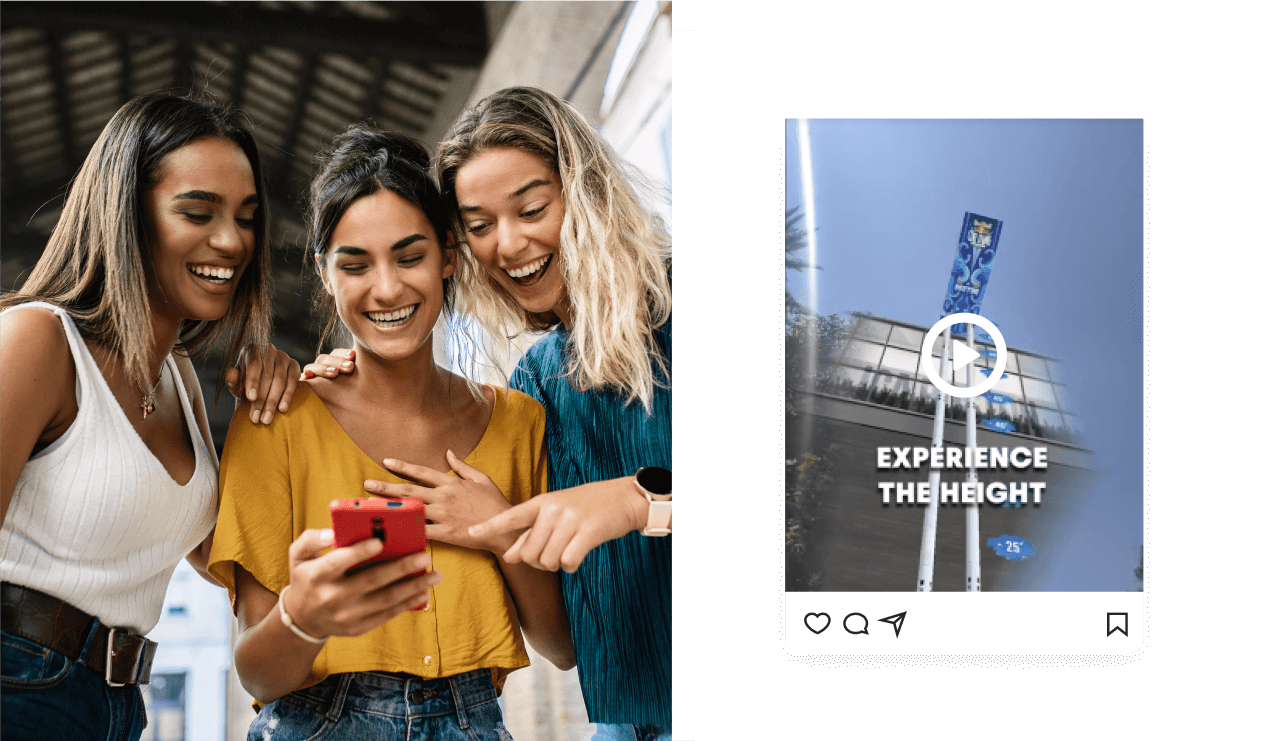
When Rock Paper Reality created a WebAR activation to promote a Red Bull diving event, it also adapted the experience for deployment on Snap and TikTok. When compared to Red Bull’s commercial marketing video, the AR promo video performed 25% better. Similarly, RPR’s Augmented Reality game for Ladbrokes saw a 20% return rate from users activated via social campaign. Selecting appropriate metrics enabled both clients to understand the impact of utilizing AR as an engagement tool, and more accurately compare the benefit of distributing via social media, comparative to other channels.
AR Filters and Lenses on Social Media
In a digital world where user experience is fundamental, social AR filters offer brands a prime opportunity to enhance customer engagement, boost sales, and define brand identity. The previously-referenced Snap/Ipsos research indicates that marketing featuring AR integration sees a 94% increase in sales conversions. In addition, the survey reports that two-thirds of customers say Augmented Reality features help them shop in a new and exciting way—and 80% of brands that integrate AR lenses and filters improve brand awareness.
How are Brands Using AR Face Filters and Lenses on Social Media?
Social media face filters and lenses overlay digital graphics onto a user’s face in real time using smartphone cameras. These filters and lenses can transform a user’s appearance or environment by adding virtual elements such as hats, glasses, animal ears, makeup, or full character transformations. They can also include interactive elements, animations, and games that respond to users’ facial movements and expressions.
For marketers, social media face filters and lenses offer an effective way to drive engagement, brand awareness, and loyalty.
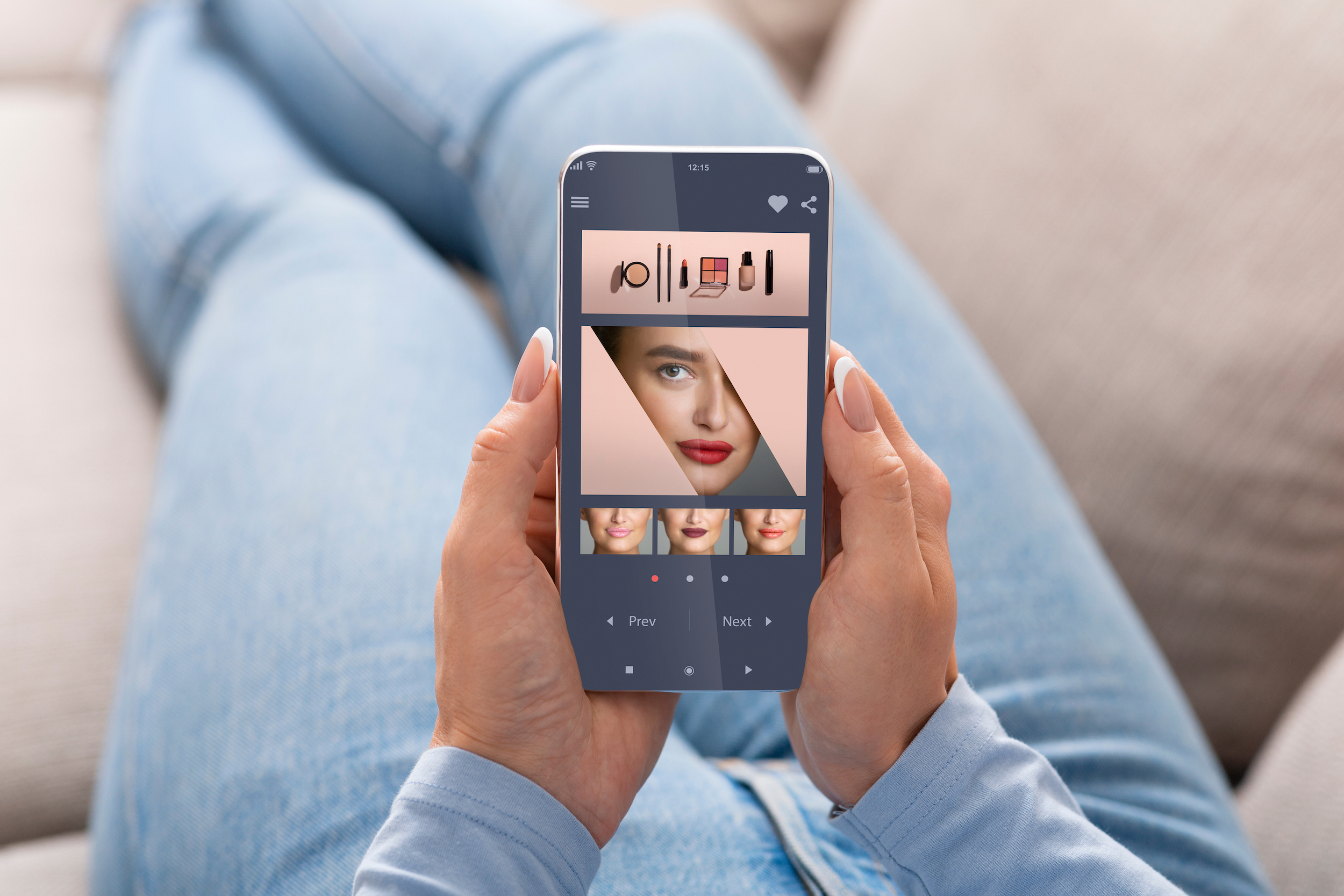
As an example, Estee Lauder offered Snapchat users the opportunity to try on two featured foundations. Users could try out 60 different shades on the social media platform. With a simple swipe, they could then proceed to make a purchase.
“Snap […] truly understands how best to communicate through this innovative medium in a creative and interactive way that resonates with our audience,” said UK & Ireland Marketing Director Nicola Casey, emphasizing how the campaign built on previous AR engagement wins. “The [AR filter] campaigns we have run so far have been really successful so we are excited to bring this latest experience to our community to enjoy.”
Italian luxury fashion brand Off-White released an Instagram AR filter for its SS19 collection during Paris Fashion Week. This filter let users virtually try on sunglasses from the collection and featured Off-White’s signature quotation marks. Besides keeping show attendees engaged with the brand while waiting for entry, the AR feature let fans around the globe participate in the launch and the fashion experience.
During the pandemic, Rock Paper Reality created AR face filters for the San Fransisco Ballet. The activation used facial gestures to trigger animations and was deployed as a way to keep audiences and donors engaged over the holidays.
What Are Location-Based AR Filters and How Can Brands Use Them?
Location-based AR filters activate when a user is at a specific geographic location. These filters overlay digital content onto the real-world environment, visible through the user’s smartphone camera. By integrating location-based AR filters into social media marketing, brands can bridge the gap between online engagement and real-world interaction.
Some strategic ways brands can implement location-based AR filters include:
- Designing games or scavenger hunts that encourage users to visit multiple locations. Users can unlock rewards, discounts, or special content by participating, which can drive foot traffic and create a buzz on social media.
- Offering exclusive filters that activate at events such as product launches, festivals, or conferences.
- Tailoring filters to reflect local landmarks, cultural events, or city-specific themes. By aligning with social initiatives, brands can use location-based AR filters to raise awareness and educate users.
As an example, Snapchat partnered with Verizon to launch a series of Lenses across the US transforming landmarks into Augmented Reality experiences. One location was the New York Public Library. When pointing their camera at the building, it transforms into a “next generation stage.” Viewers experience the library’s transformation into a scene of florals, animals, and a dancing man.
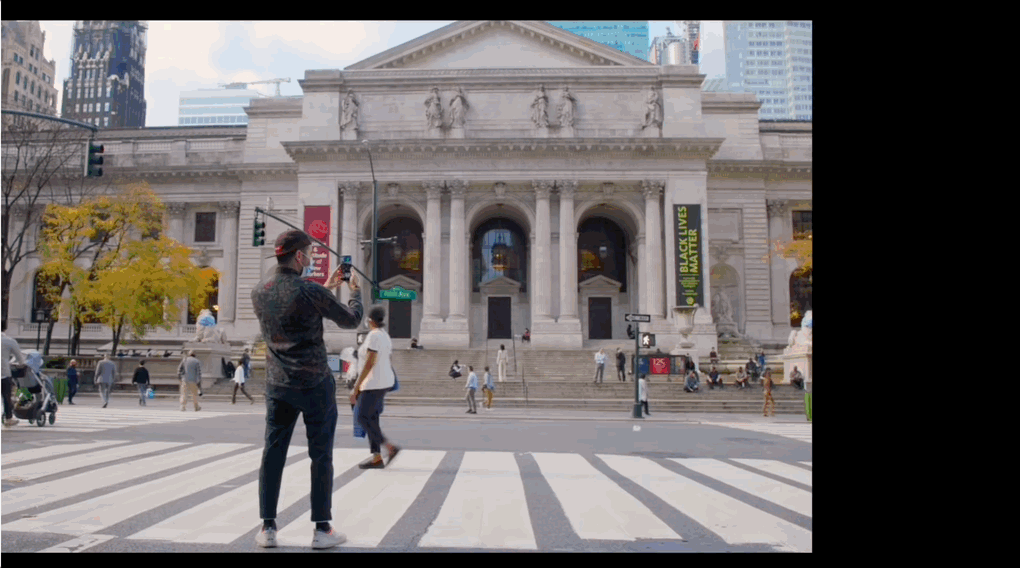
Credit: Fishermen Labs
AR Shopping on Social Media Platforms
AR has become a transformative tool in enhancing the online shopping experience. A Global Report from Snap and Ipsos shows that 65% of consumers feel that AR makes the shopping experience easier, and 79% are interested in AR product interactions before making a purchase. In addition, 90% of fashion brands agree that AR broadens the range of apparel that customers can easily try on.
Shopping with AR on Social Media
AR can help consumers feel more confident about their purchases, letting them visualize, share, and gather feedback before making decisions. Thanks to brand integration with platforms like Instagram and Snapchat, users can try products like jewelry, makeup, or clothing using their smartphone cameras—and then seamlessly buy them without leaving the app. This not only simplifies the path to purchase, but offers a highly personalized experience that maximizes the likelihood of conversion.
AR enables a seamless connection between online and offline channels, offering cross-channel marketing opportunities. In-store marketing may encourage the shopper to engage with AR content on social media, or AR social media content may encourage users to visit a store, driving interaction and engagement wherever audiences are.
Kohl’s, for instance, partnered with Snapchat to launch an AR Virtual Closet feature. It allows users to browse, fit, and purchase Kohl’s fashion selections directly within the Snapchat app.
AR Event and Brand Activations Using Social Media
Introducing a new product or promoting an event can be challenging without a strong base of social proof to drive demand. AR is a handy tool to overcome this challenge, as it can bring a product to life before it even hits the market.
The true value of AR for brand activations lies in its interactive nature and its scalability. It’s easy to adapt AR experiences for different markets, customizing details as needed. Plus, AR can be seamlessly incorporated into both physical in-store promotions and digital marketing campaigns, potentially boosting the impact and success of the product launch throughout its lifecycle.
Using AR to Share Exclusive Content
Exclusive content makes people feel special, like they’re part of a select group with access to something unique. This can increase their interest, engagement, and loyalty to a brand. Exclusive offerings are intended to seem more valuable because they are not available to everyone; this perceived value can make people more willing to engage or purchase.
Integrating AR into a pre-launch strategy lets potential customers experience a product in advance as an exclusive sneak peak. It can also play a role in gathering valuable data through social media and building confidence in targeting the right audience.
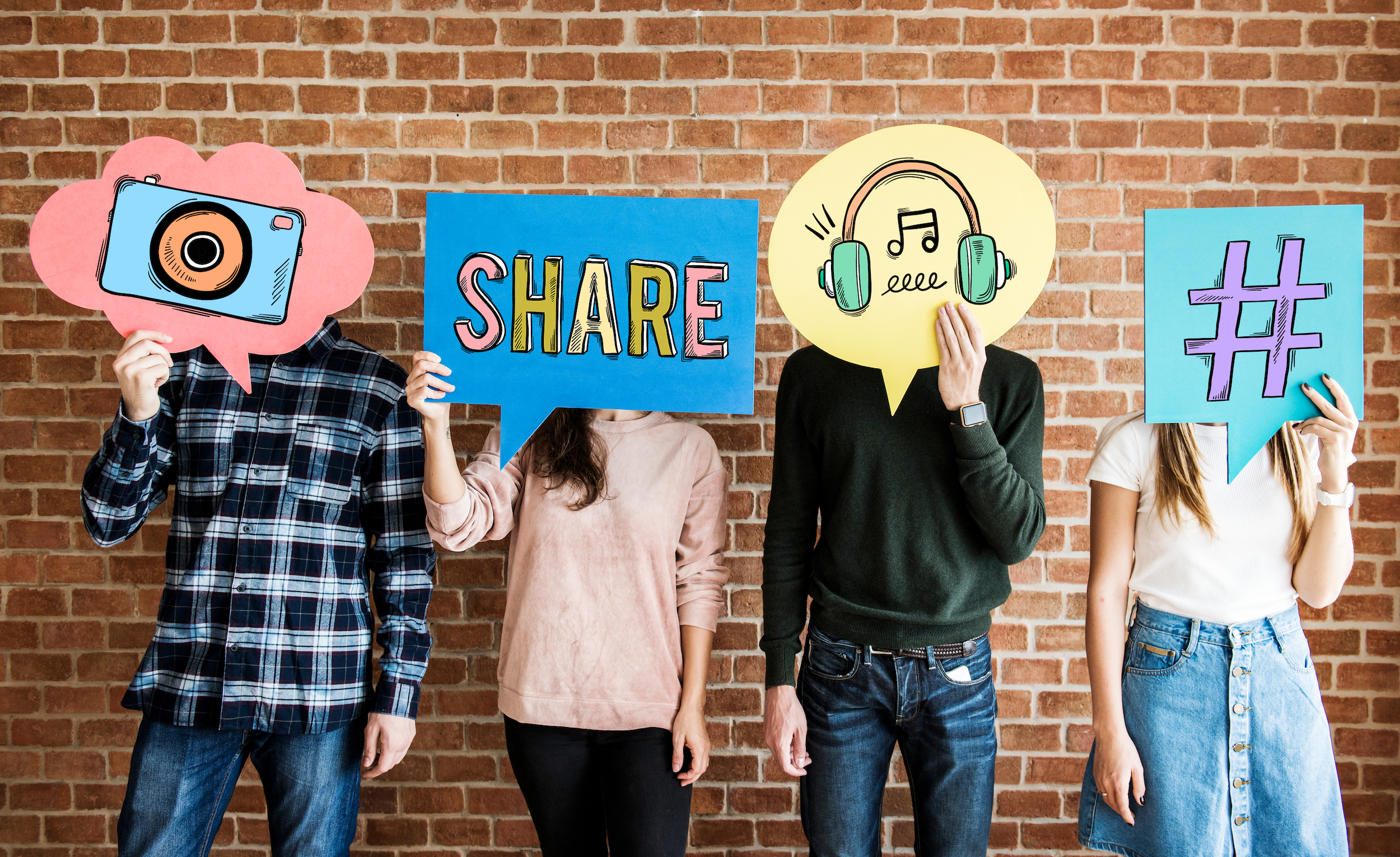
During live events or product launches, exclusive and immersive experiences can include behind-the-scenes content that adds an extra layer of engagement, like with the Off-White example mentioned earlier. For example, users might gain access to a virtual tour of a facility or see the making of a product with interactive AR elements. Companies can also provide special AR codes on their social media that users can scan to access exclusive promotions or discounts.
What Is the Future of AR in Social Media?
The future of social media is inextricably linked with AR’s transformative influence. AR’s capacity to blend the digital with the physical realm is not merely an enhancement—it’s redefining engagement paradigms. In an era where the digital landscape is incessantly noisy, AR can offer a refreshing opportunity to captivate attention in interactive and shareable ways. The numbers speak for themselves: 57% of users are more likely to buy from a brand offering AR experiences, and 64% of consumers express that AR use increases their sense of loyalty towards a brand.
Rock Paper Reality is committed to crafting bespoke AR experiences that not only capture imagination, but also deliver tangible business outcomes. In leveraging AR, we’re not chasing trends—we’re shaping a new standard for audience engagement.
Let’s sculpt your AR narrative and pioneer an immersive social media landscape together. Connect with us to begin your journey.
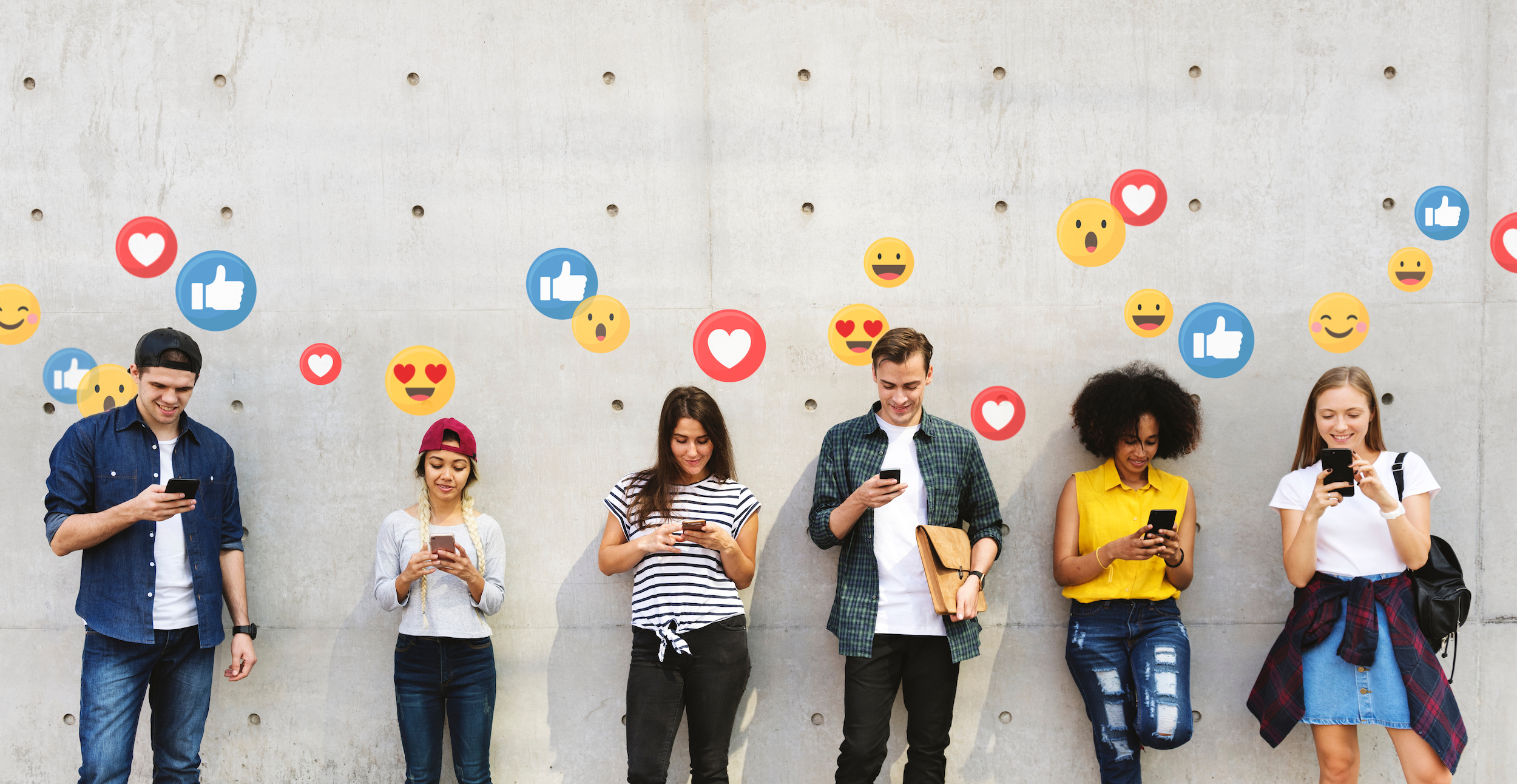
FAQs for AR in Social Media
What Are the Best AR Advertising Strategies for Social Media?
When integrating AR into your social media strategy, some best practices might include:
- Creating interactive filters and lenses that promote brand engagement
- Leveraging influencers to showcase AR features that resonate with followers
- Gamifying experiences to incentivize user participation
- Using data to personalize AR content, thereby increasing relevance and impact
How Is AR Being Used in Live Streaming on Social Media Platforms?
By overlaying digital graphics onto real-world broadcasts, AR allows streamers to add creative visual effects, face filters, and backgrounds in real time. Brands also use AR to showcase products, host virtual try-ons, and create immersive brand stories during live events.
What Are the Future Trends of AR in Social Media?
Some future trends might include:
- More realistic and sophisticated filters
- Integration of virtual and physical retail experiences
- Social shopping with instant purchases
- Personalized content based on user behavior
- Interactive live events
